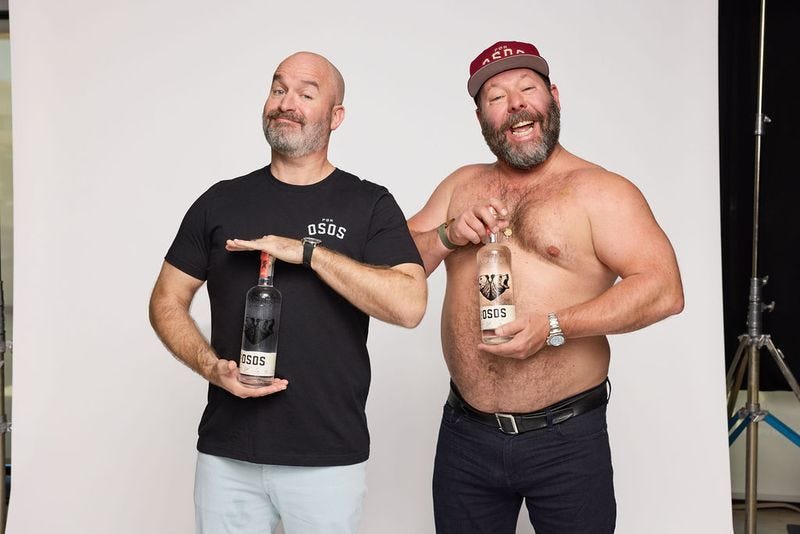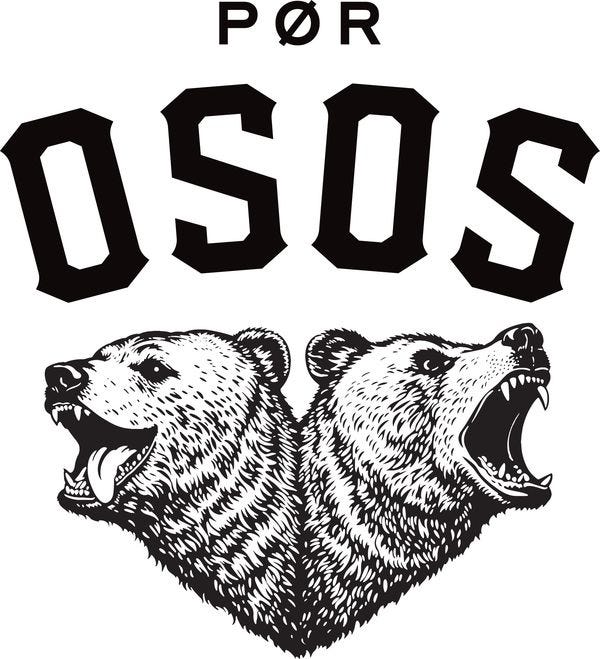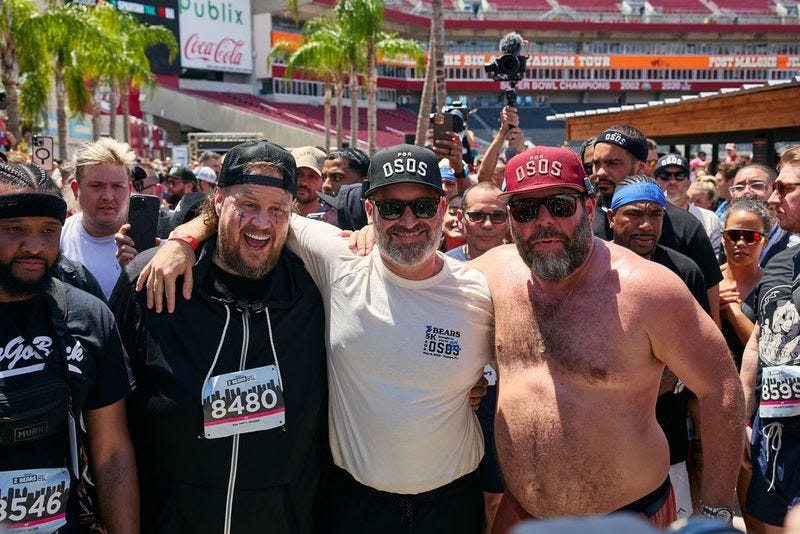The word flywheel gets tossed around a lot these days. Guilty as charged.
But as the focus shifts from audiences to communities, the ability to grow both those communities and EBITDA increasingly depends on diversification—and yes, the flywheel.
For many on the legacy side—and even some on the creator side—building outside your core business feels mysterious. There’s no structure, no path. Every model is its own snowflake.
That’s why I thought it might be useful to look at companies that build the harder-to-grasp parts of the flywheel. Enter DRIP MFG.
You may not know the name, but if you follow comedy giants Bert Kreischer or Tom Segura, you’ve probably seen their vodka brand, Por Osos. And if you’ve been watching creator commerce, you know how fast that vodka exploded onto the market. Tom and Bert’s star power is undeniable, but the secret weapon was Drip—the company that sourced, built, and launched Por Osos.
It was their first launch. But once you meet the team, you realize it wasn’t a fluke. They’ve been at this digital commerce game since its earliest days. And with Bert and Tom’s permission, they walked me through how they did it—a masterclass in how communities become commerce.
The People Who Build
Angelo Castañeda came up through the wild west years of affiliate marketing, mastering funnels and conversions back when Facebook was wide open.
Ryan Quinn cut his teeth at Reef and Vans, then helped turn Stance into a $100M+ lifestyle brand before running consumer products at Rooster Teeth and Night Media, where he incubated MrBeast’s Feastables.
Their shared DNA: find the white space, build products with taste, and ship through communities—not billboards.
The JV, Not the License
When Kreischer and Segura started exploring alcohol, the easy road was a licensing deal: 10–15% equity for name and posts. They passed.
“They didn’t want to rent their likeness. They wanted to build. Our model is a true joint venture: they keep control and majority; we do the heavy lift and take a meaningful minority,” Angelo told me.
Bert and Tom provided all the start-up capital to incubate the brand, and then just before launch, Drip served as the investment resource by going out and successfully completing a Series A capital raise from external investors for Por Osos.
This fresh working capital was instrumental in allowing Drip to purchase more inventory, and hire in the spirit industry experts—a CEO with over 20 years of spirits industry experience, a seasoned VP of sales, and most recently an industry-specific CMO.
This allowed Por Osos to come out swinging in a big way as a new entrant in the vodka space. Drip earned its 40% through sweat equity—building everything from sourcing to trademarks to distribution. That upfront commitment is why the JV was real, not symbolic. And this is the framework that Drip will follow to launch new brands with new creators.
A Masterclass in Product-Market Fit
The team could have gone tequila—that’s where every celebrity was running. Whiskey was smaller, more niche. Gin was barely 5% of the market.
But vodka?
Vodka made up nearly a third of U.S. spirits and hadn’t seen a new culturally loud entrant since Tito’s took off fifteen years ago.
As Ryan put it: “Tito’s popped 15 years ago. Crystal Head sits at $75. In the biggest category, there wasn’t a new, culturally loud entrant. That’s the gap.”
The pivot moment came in a Drip working session when Tom looked around the room and said: “Are we fucking crazy not to do vodka?”
For Bert, the fit was undeniable. His “Machine” story is vodka-soaked. His switch to vodka sodas—after a model on a plane told him it had fewer calories than beer—became a running bit on Rogan. For years he was essentially pitching Tito’s for free. Vodka wasn’t a stretch. It was his brand DNA.
From there, Drip took over. They pulled in advisors, blind-tasted the market, and sourced the production team.
They found a Houston lab that had spent seven years perfecting a patented finishing method: running electricity through the spirit to split molecules, then bubbling food-grade CO₂ to strip out impurities.
The result was unusually smooth. It’s a first class sipping Vodka at Economy Plus prices.
They doubled down with non-GMO Italian wheat as the base—deliberately more expensive than the corn Tito’s uses.
And instead of cutting costs with a stock bottle, Drip hired an industrial designer to laser-cut a custom mold.
Every choice was theirs: deliberate, expensive, and designed to cut against the easy “cash-grab” celebrity playbook.
The final package was premium where it mattered but still accessible on the shelf: $22 for a 750ml bottle. A product built, sourced, and executed by Drip—then handed to Bert and Tom to carry into their community.
The Authenticity Imperative
This wasn’t a celebrity endorsement. It was a genuine extension of Bert’s persona. As Angelo put it, “If you catch Bert on a random weekend, chances are he’s drinking vodka.” That reality gave Por Osos a moat: authenticity.
But it wasn’t just Bert.
Tom and Bert’s friendship—the heart of Two Bears, One Cave—is what pulls fans in. Communities of people longing for connection turn to shows like theirs to feel part of something real.
Watching Bert and Tom build a company together wasn’t just a business play; it became part of the story fans were invested in. People weren’t just buying vodka. They were rooting for two best friends to succeed.
Bert himself made the point on stage. During the launch episode of Two Bears, One Cave, he grinned into the mic and said: “This is more exciting than the birth of my daughters.”
Half a joke, half the truth—and proof of his buy-in.
The Go-to-Market Flywheel
Most brands pitch distributors first, then try to generate demand. Por Osos flipped the model: build proof of demand, then force distributors to chase you.
Phase 1: Secret Development. The project stayed under wraps until the team had the product, story, and design locked.
Phase 2: Digital Reveal. The podcast episode became the pebble that hit the water, rippling instantly across a million listeners.
Phase 3: Physical Proof of Concept. Super Bowl weekend in Vegas wasn’t a vanity play—it was leverage. MGM Arena co-headline show, chandelier bar takeovers, a punt-pass-kick activation. $45,000 in merch sales in a single night. Thousands of fans engaged with the brand before it even hit shelves.
Phase 4: Continuous Conversion. Bottle signings drew up to 1,000 people at a time. At one ABC Fine Wines & More event, Por Osos broke the record for most bottles ever sold in a single celebrity liquor brand engagement day—over 850 bottles moved. One Florida ABC Fine Wine moved 863 bottles in two hours.
And then there was the arena moment.
As Tom finished his set at the MGM Grand, Bert ripped his shirt off, stormed the stage with a Por Osos bottle, and shouted: “Let’s drink Por Osos!” before doing a shot with Tom in front of 16,000 fans.
Distribution Is Earned
The point of Vegas wasn’t spectacle. It was receipts. Retailers and distributors don’t move on hype; they move on proof—velocity, reorders, turnout.
First year case depletions: 10,500. The team expects to beat that number in 2025. Distribution followed demand, anchored by top states (Texas, Florida, California, South Carolina, Illinois, Nevada) and powered by chains like Specs (95% reorder rate in TX), Total Wine (90% reorder rate multi-state), ABC in Florida, BevMo and Safeway in California, Lee’s Liquor in Nevada, and Binny’s in Chicago.
The momentum isn’t just state-level—it’s city by city. Austin and Dallas in Texas; Orlando, Tallahassee, and Tampa in Florida; Fort Worth; and Chicago have all become early revenue leaders. This is the granular proof distributors look for before they lean in.
The Unsexy Stuff That Actually Moves Cases
Creators can spark attention.
But alcohol moves through blocking and tackling. Weekly distributor calls. Ride-alongs with field reps. In-store demos. Event ads: $100–500 social ad spend for one week leading up to bottle signings or bar takeovers, geo-targeted by location. Merch drops: primarily email list and Bert/Tom resharing, with occasional $100–300 social ad spend for one week.
At this stage, the team relies mainly on non-paid outreach for events and merch, though they plan to scale budgets as they grow.
As Angelo put it: “We don’t rely on free reach. You still have to fund the line—tastings, local ads, partner merchandising. That’s how shelves turn.”
Why Drip Matters
Creator commerce keeps failing for the same reasons TV shows fail: wrong package, wrong timing, no distribution, no stamina.
Por Osos worked because:
Right category, matched to a true story.
JV structure with real skin in the game.
Launch designed to generate proof, not applause.
Relentless operational grind behind the curtain.
Por Osos wasn’t luck. It was a blueprint. And Drip isn’t stopping at vodka. Supplements, snacks, functional beverages—the pipeline is already filling.
There are other companies out there offering similar structures (and surely I’ll write about them eventually). But I love how handcrafted and careful these guys are. Talking to them was a masterclass.
Keep an eye on what they launch next. Or, if you’ve got the goods and the grit, give them a call.







